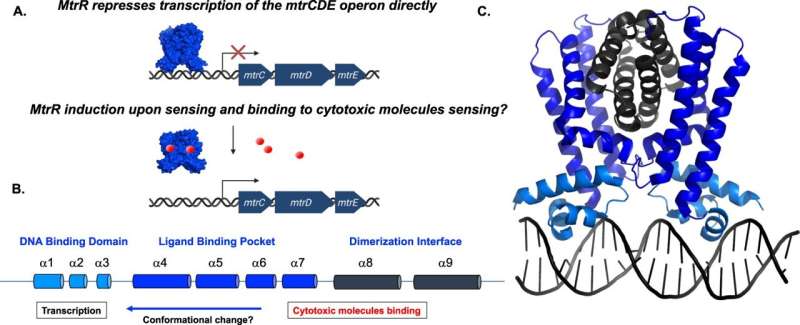This article has been reviewed according to Science X's editorial process and policies. Editors have highlighted the following attributes while ensuring the content's credibility:
fact-checked
peer-reviewed publication
trusted source
proofread
How sex hormones help gonorrhea fight off antimicrobials and antibiotics

Oral birth control packages warn that the medication won't prevent STIs. In the case of gonorrhea, the sexually transmitted bacterium that causes the disease can use those hormones to help it resist antibiotic attacks.
Like many bacteria, this bug, Neisseria gonorrhoeae, is equipped with pumps to push the killing chemicals out of its cells. But what's unique, according to a Duke and Emory study appearing in Nature Communications, is that the hormones of the human urogenital tract actually allow gonorrhea to make and use more of these pumps to fight intrinsic antimicrobials and prescribed antibiotics.
The researchers uncovered the trick while examining a transcription factor—a protein that binds to specific sites on the bacterium's DNA and slows production of the efflux pumps that protect it.
Led by Duke graduate student Grace Hooks and her mentor, Biochemistry chair Richard Brennan, Ph.D., the study used a variety of approaches to characterize the shape and function of the transcription factor.
They found that unfortunately, this transcription factor, called MtrR, has an affinity for binding to the hormonal steroids progesterone, estrogen and testosterone and the synthetic hormone ethinyl estradiol. When it binds to a hormone, the transcription factor becomes less effective at suppressing the production of bacterial pumps.
Hooks explained that the bacterium appears to be able to sense its hormonal environment, and waits for the opportune time in the female's menstrual cycle to ramp up its colonization.
Estrogen rises dramatically in the week before ovulation, and progesterone peaks in the two weeks between ovulation and menstruation. These fluctuations are thought to suppress the immune system, giving sperm and eggs a window of opportunity to survive in the urogenital tract, but that same window also creates a vulnerability to this infection.
"It's kind of utilizing this sensory system to gauge where it is in this cycle and when it can best colonize," Hooks said. "It can only survive in the human host, it can't survive outside. So, it has to really be good at sensing where it is and when's the best time for colonizing."
The transcription factor MtrR also helps signal the bacterium to protect itself against reactive oxygen species. "What this one protein does is a dual system to protect Neisseria gonorrhea," Brennan said.
Gonorrhea has been with humans far longer than there have been antibiotics, appearing in texts as ancient as 2600 BC and making famous appearances in Julius Caesar's Roman legions and the Crimean war.
Ancient or not, the Centers for Disease Control considers gonorrhea an urgent public health threat, because it is now resistant to every antibiotic except for one, ceftriaxone. But strains resistant to this antibiotic have been identified recently in Europe and Asia.
Known historically and colloquially as "the clap," untreated gonorrhea in women can lead to pelvic inflammatory disease and infertility. It may also be passed from mother to infant during childbirth.
While the infection is more obvious in men, it is less dramatic, as men don't experience the wider hormonal shifts, nor is their urogenital tract as complicated or deep as a woman's, Hooks said. But men still carry all the same hormones that the transcription factor latches onto, she added.
And, of course, the bacteria must thrive in both men and women to be a successful STI. "Neisseria gonorrhoeae is an obligate human pathogen," Brennan said. "We don't know where it is the rest of the time."
When Hooks presented some of her data in a laboratory meeting, fellow graduate student Emily Cannistraci from the next-door Schumacher laboratory asked if the synthetic hormone ethinyl estradiol, which is found in many oral contraceptives for women, would have a similar effect. Hooks checked, and it certainly did.
The takeaway is not only the package warning that oral birth control won't prevent STIs, but in this case, it might even make them worse.
More information: Grace M. Hooks et al, Hormonal steroids induce multidrug resistance and stress response genes in Neisseria gonorrhoeae by binding to MtrR, Nature Communications (2024). DOI: 10.1038/s41467-024-45195-1




















